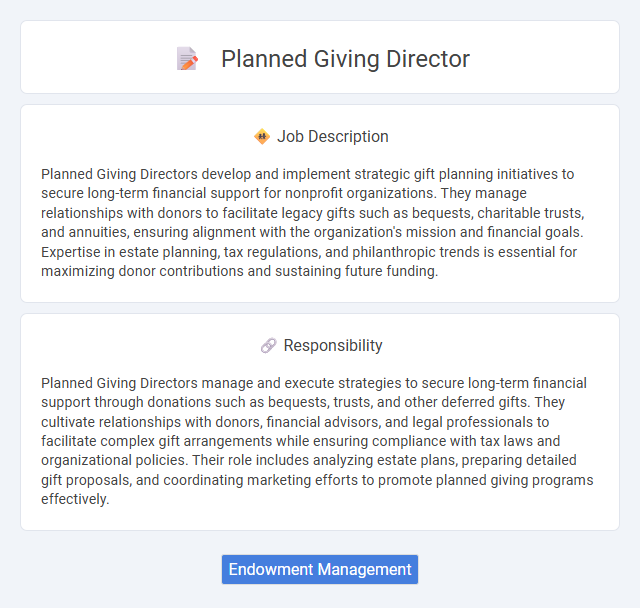
Planned Giving Directors develop and implement strategic gift planning initiatives to secure long-term financial support for nonprofit organizations. They manage relationships with donors to facilitate legacy gifts such as bequests, charitable trusts, and annuities, ensuring alignment with the organization's mission and financial goals. Expertise in estate planning, tax regulations, and philanthropic trends is essential for maximizing donor contributions and sustaining future funding.
Individuals with a passion for philanthropy and strong interpersonal skills are likely to find success as a Planned Giving Director. Those who possess a detail-oriented mindset, along with experience in finance or law, may be particularly well-suited to navigate the complexities of gift planning. Candidates lacking patience or discomfort with long-term relationship building might face challenges in this role.
Qualification
A Planned Giving Director typically holds a bachelor's degree in fundraising, nonprofit management, or a related field, with many employers preferring a master's degree in philanthropy or business administration. Proven experience in major gift fundraising, estate planning, and charitable giving strategies is essential, alongside strong knowledge of tax laws and financial instruments relevant to planned giving. Excellent communication, relationship-building skills, and proficiency in donor management software are critical to successfully developing and stewarding long-term philanthropic commitments.
Responsibility
Planned Giving Directors manage and execute strategies to secure long-term financial support through donations such as bequests, trusts, and other deferred gifts. They cultivate relationships with donors, financial advisors, and legal professionals to facilitate complex gift arrangements while ensuring compliance with tax laws and organizational policies. Their role includes analyzing estate plans, preparing detailed gift proposals, and coordinating marketing efforts to promote planned giving programs effectively.
Benefit
A Planned Giving Director likely enhances an organization's long-term financial stability by securing committed future donations through wills, trusts, and other planned gifts. Their expertise in cultivating relationships may increase donor retention and encourage larger contributions. This role probably offers strategic value by aligning donor interests with the organization's mission, maximizing philanthropic impact.
Challenge
The role of a Planned Giving Director likely involves navigating complex donor relationships and aligning long-term philanthropic goals with organizational needs. Managing legal, financial, and ethical considerations may present ongoing challenges requiring strategic foresight and adaptability. The position probably demands balancing stakeholder expectations while optimizing planned gift portfolios for sustained impact.
Career Advancement
Planned Giving Director roles provide strategic leadership in developing and managing charitable giving programs, enhancing donor engagement, and securing long-term funding for nonprofit organizations. Professionals in this position gain expertise in estate planning, tax regulations, and philanthropy, which can lead to advancement into senior fundraising executive roles, such as Chief Development Officer or Vice President of Advancement. Mastery of planned giving strategies and relationship-building with high-net-worth donors significantly boosts career growth opportunities within the nonprofit sector.
Key Terms
Endowment Management
A Planned Giving Director specializing in endowment management oversees the strategic development and growth of an organization's endowment funds through planned giving programs, ensuring long-term financial stability. They collaborate with donors to structure gifts such as bequests, charitable remainder trusts, and life income agreements that align with the institution's philanthropic goals. Expertise in investment policies, tax regulations, and donor relations is essential to maximize the impact and sustainability of endowment assets.
 kuljobs.com
kuljobs.com